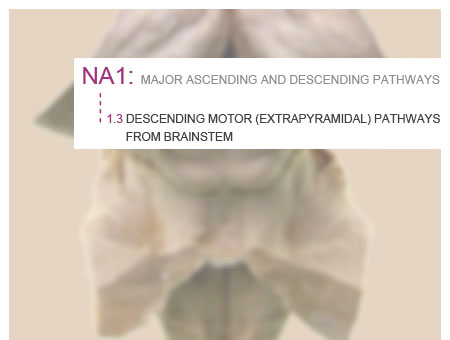 |
|
|
 |


 |
1.3: Descending motor (extrapyramidal) pathways from brainstem
Note: The term "extrapyramidal motor system" has in the past also been used to include the basal ganglia (striatum, globus pallidus etc) which were thought to provide a motor pathway separate from the pyramidal system (corticospinal tracts). Later evidence proved that the basal ganglia have a completely different function in controlling motor activities.
|
|
- These pathways have their neuronal cell bodies in the brainstem.
- They are concerned primarily with reflex movements related to balance and body posture.
- They also have other important functions including the coordination of extrinsic eye muscles (i.e. those which rotate the eyeballs), and cooperation with the pyramidal system to achieve effective movement of the neck and trunk.
- They include:
From the midbrain:
- Rubrospinal tract (from the red nucleus) - not well (or at all) developed in humans.
- Tectospinal tract (from the superior colliculus - visual and auditory inputs important, e.g. in startle response to bright light and loud noises, respectively).
From the pons and medulla:
- Vestibulospinal tract (from the lateral vestibular nucleus - important in acheiving balance and posture).
From the entire brainstem:
- Reticulospinal tract (from reticular formation nuclei) - have multiple inputs from different senses and from the cerebral cortex. Important in the descending inhibition of spinal reflexes, and in helping to steer the voluntary movements created by the corticospinal system.
- Medial longitudinal fasciculus (interconnecting eye muscle nuclei, vestibular nuclei on both sides, and descending to motor neurons supplying the neck and upper trunk muscles).
|
|
|
 |
© King's College London 2011 | Content & original graphics by Professor Lawrence Bannister | Interface design & development by EHM, CTEL | Content development by Julia Warner, VC TEL |



